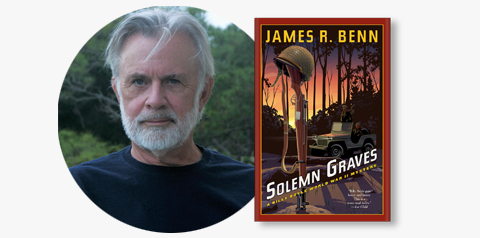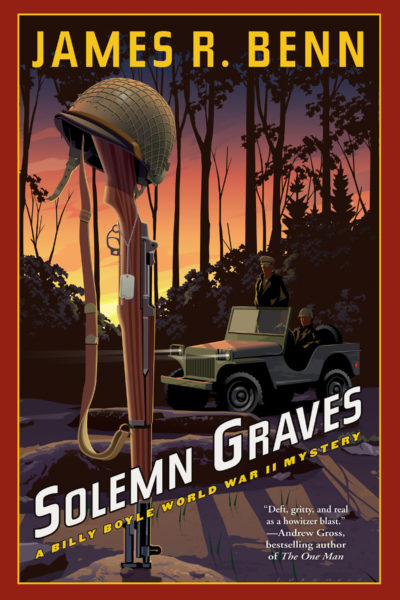
Solemn Graves, the thirteenth book in James R. Benn’s endlessly fascinating Billy Boyle series, hit shelves this month.
To commemorate its release, Soho Press is offering a limited edition series set of signed postcards. The first card in each set is signed and lettered by the author, making this the ultimate collector’s item for Billy Boyle fans!
The author was kind enough to discuss what went into the researching and writing of Solemn Graves. Our interview is below.
What’s your new book about?
There’s a murder, of course, one that threatens a closely-guarded military secret. But what the book is about in terms of theme is the épuration sauvage, or the wild purge, during the period between the liberation of French territory and the establishment of a French civil government. It was a time of violence, when the French turned on themselves in an orgy of retribution. Over ten thousand people were executed without trial. Robespierre would have been quite at home during July and August of 1944 in some parts of France. There was also a lot of violence against women; think of all those photographs of leering men shaving the heads of women. Some were collaborators, others were victims of mob violence.
What attracted you to the idea/concept of the book?
I’m fascinated by the whole notion of collective memory and how French society obliterated the reality of what happened after their defeat and during the Occupation. In 1940 there was a general acceptance that Germany had won the war and England would also soon give in. The Resistance hardly existed. Many people decided to just get on with their lives and accept the new order. But as England held on and America came into the war, things changed. It was the beginning of the myth of national Resistance. While there many engaged in active work against the Germans, most historians agree the number amounted to about 2% of the French population. By the time Paris was liberated, many more would lay claim to the title of resistant.
What kind of research was required?
My wife and I have visited Normandy, and I relied on much of what I learned there. The military situation in Solemn Graves revolves around the intense hedgerow fighting in what the French call the bocage—tall mounds of stones and shrubs bordering fields—which made for hard and slowing fighting. We stayed at a farmhouse and I remember the madame telling us she grew up six miles from the invasion beaches, and it took the Americas a month to reach her village. It was all supposed to go much more quickly, and with less loss of life. As towns and villages were destroyed, ground down between the opposing armies, many of the locals wondered if the Germans might well return. It initial euphoria diminished as civilian casualties and the destruction of property increased.
Which books or authors influenced you while writing this book?
I read several accounts of the US Army divisions which fought in Normandy, in particular the 30th Infantry Division, which the Germans nicknamed “Roosevelt’s SS”. That gives you some idea of the ferocity of the fighting.
The Ghost Army of World War II by Rick Beyer and Elizabeth Sayles was invaluable in describing the deception campaigns of a little-known group of artists, sound engineers, set designers, actors, and other free spirits who were recruited for their ability to deceive. Their actions were so successful that the unit history was classified for forty years after the war, in case the tactics might be needed again, against the Russians. Some elements are still top secret to this day.
But the most influential book was definitely Les Parisiennes: How the Women of Paris Lived, Loved, and Died Under Nazi Occupation by Anne Sebba. It is a remarkable non-fiction book, a new way of looking at the role of women in the Resistance and French society in general. She describes how the humiliation of the defeat and the impotence of men during the Occupation played a role in the subsequent shaming of women during the Liberation, and the white-washing of their active role in resisting Nazi rule. A fascinating, eye-opening book.
Did anything not make it into the book that readers might find surprising or interesting?
There’s a story in Les Parisiennes which I cannot shake. It happened at the end of the war, so of course it couldn’t be in this book. Women taken prisoner by the Gestapo were sent to a special concentration camp in Germany, Ravensbrück. As well as members of the Resistance, female British agents were also sent there. For some unknown reason, the methodical Germans took their clothing and packed it away when they were issued the familiar striped pajama uniform. When the camp was finally liberated, those original clothes were all they had for the return trip home—the survivors, that is. Some of the Parisian women had been arrested while dressed in evening gowns, which they had to wear on their emaciated, tortured bodies. Because of typhus, their heads had been shaved. When they emerged from the train at a Paris station, they were mistaken for tondues – the shorn, those women who had their hair cut off for collaboration – and abused by the gathering crowd.
When readers finish the book, what do you hope they will think and feel?
Paul Fussell, the literary historian, author, professor, and WWII combat veteran, wrote as essay on the film Saving Private Ryan, in which he said, “I’d like the Omaha Beach section made into a self-contained pseudo-documentary titled Omaha Beach: Aren’t You Glad You Weren’t There?”
I’d like readers to close this book and think, Thank God I wasn’t in Normandy.
And remember those who were.
***
“Exceptional … Benn has never been better at integrating a whodunit plot line with a realistic depiction of life on or near the battlefield.” –Publishers Weekly, Starred Review
Buy from IndieBound | Buy from Barnes & Noble | Buy from Amazon | Buy from Soho Press

